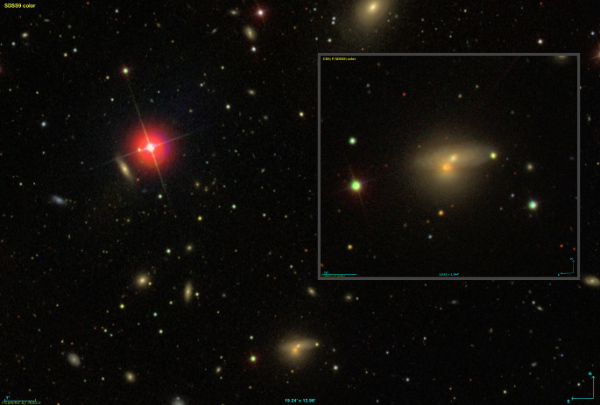ACO 2197 Group in Hercules
May 2018 - Galaxy of the Month
When we think of galaxy clusters in Hercules people tend to focus on ACO 2151, perhaps better known as the Hercules cluster, and ignore the other two bright(ish) galaxy clusters ACO 2199 and ACO 2197. I have covered ACO 2199 in a very early Galaxy of the Month (GOM) when focusing on its brightest member NGC 6166 so this time we will focus on ACO 2197.
ACO 2197 is part of the great wall of galaxy clusters which includes the Coma Cluster (ACO 1656), the Leo Cluster (ACO 1367) and the Hercules Cluster (ACO 2151). It lies only a short distance on the sky, about 1.5 degrees, from ACO 2199 and there is evidence of a filament of galaxies linking these two clusters with ACO 2151. ACO 2197 and 2199 along with 2151, 2152, 2147 and 2162 comprise the Hercules Supercluster.
Classified as a type III cluster on the Bautz-Morgan system ACO 2197 is a fairly irregular cluster containing 11 galaxies catalogued in the NGC so it should perhaps be better known.
It is covered (as expected) in the Webb Deep-Sky Society Observer's Handbook (WSDSOH) Volume 5 and also on Albert Highe’s web page which includes a detailed list of galaxies in the cluster as well as a finder chart for the central region.
The brightest three galaxies in the cluster, NGC 6160, NGC 6173 and NGC 6175 were all discovered by William Herschel in 1787. At the same time Herschel also found the fainter galaxies later catalogued as NGC 6146 and NGC 6150. John Herschel also discovered a number of nebulae in the cluster but as these are getting quite faint the other NGC objects were discovered by the Rosse team and Stephan. The Rosse team did discover two other galaxies in this field that did not make it into the NGC.
ACO 2197 is quite a large cluster in spatial terms covering almost 1.5 degrees in length on the sky. A brief observation of this cluster with Andrew Robertson’s 610mm reflector on a very transparent night suggests that a lot of galaxies may be visible in the field (we had been following galaxies in the ACO 2199 cluster for such a distance I was checking we had not run into the ACO 2197 cluster by mistake).
As with ACO 2199, ACO 2197 is dominated by a giant cD galaxy, in this case NGC 6173 along with two other giant ellipticals (NGC 6146 and NGC 6160). The cluster is thought to be at a distance of perhaps 126 Mpc. In terms of galaxy numbers ACO 2197 would appear to contain maybe 1500 galaxies or more, so it is quite a large cluster. It may also be interacting with ACO 2199 as the clusters may only be 9.2 Mpc apart in space.
The cluster appears to form an E-W alignment based on the bright galaxies NGC 6146, NGC 6160 and NGC 6173, a line almost a degree long. As such even with modern wide field eyepieces this cluster is going to take quite a few fields to study. It may however be more tractable than the galaxy fields of Coma. It does seem that in general the galaxies congregate at either end of the cluster around NGC 6146 and NGC 6173.

One of the more interesting galaxies in the group is the double galaxy NGC 6175, which appears to be a spiral and an elliptical almost on top of each other. The pair would appear to be included in the updated VV catalogue as VV 1816, although I am not sure of evidence of interaction. It would be an interesting challenge to see what aperture telescope is needed to split this pair. As always good seeing will be needed as well as good transparency I would think.
Having said all this it is probably worth noting that the Night Sky Observer's Guide (NSOG) regards the brighter galaxies in this group as challenges for 16/18” telescopes.
Owen Brazell - Galaxy Section Director